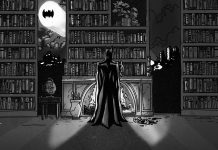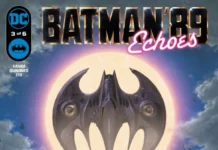“This is my shot at doing The Great Superhero Story, and bringing
every ounce of craft to it that I can.” – Frank Miller (1985)
 It’s fitting that when THE DARK KNIGHT RETURNS was released in the Spring of 1986 its cover was graced with an iconic thunderbolt. That’s precisely what hit the comic book industry and the rumblings haven’t yet run their course.
It’s fitting that when THE DARK KNIGHT RETURNS was released in the Spring of 1986 its cover was graced with an iconic thunderbolt. That’s precisely what hit the comic book industry and the rumblings haven’t yet run their course.
It’s perhaps easy to give THE DARK KNIGHT RETURNS too much credit as the ground for its breakthrough was being laid all around the industry. Much of what made THE DARK KNIGHT RETURNS possible was the result of the success of the direct market. Free from the strictures of the Comics Code Authority, and before Marvel, DC, and Image glutted the market, it allowed for bold experimentation in such titles as AMERICAN FLAGG!, LOVE AND ROCKETS, MAUS, and RONIN. And the ready availability of back issues allowed for far more complex and serial storytelling. Dave Sim would tell stories spanning years in CEREBUS and collect them in large trade paperbacks which would soon be the standard for the industry. The independents were experimenting with more adult takes on superheroes in titles like NEXUS. Meanwhile, the British writers and artists were opening eyes with the satirical JUDGE DREDD and the way that Alan Moore reinvented SWAMP THING and would close the books on pre-Crisis SUPERMAN.
The possibilities seemed endless at the time.
However, it was still a bold move to take a superhero as well-known as Batman and throw him into the adult mix. Obviously, comics were growing up, but even the direct market graphic novels from Marvel and DC seldom featured material that wouldn’t pass the Comics Code Authority. It was still regarded as a risky move that risked alienating parents and readers.
Perhaps it’s because DC was getting whipped by Marvel in the early part of the 1980s that made the risk seem worth taking for DC. Or perhaps it was simply that editor Dick Giordano had his finger on where the superhero medium was heading. In 1986, DC was in the midst of reinventing itself for its post-Crisis re-launch and Frank Miller wasn’t going it alone. THE DARK KNIGHT RETURNS shared shelves with Howard Chaykin’s violent update of THE SHADOW, Alan Moore’s masterpiece WATCHMEN which started out as a Charlton heroes project, and John Byrne’s reimaging of Superman in THE MAN OF STEEL. The initial centerpiece was THE DARK KNIGHT RETURNS and DC spared no expense promoting it, even securing a major article hyping it in ROLLING STONE.
 Still, all the groundwork laying and editorial risk taking means nothing without the right talent involved and there’s little doubt that courting Frank Miller to lead the reinvention of Batman was one of the all-time best decisions made by DC comics. Rereading THE DARK KNIGHT RETURNS for the umpteenth time over the decades since it was released, the power of the book is hardly diminished, even after it’s be repeatedly mined for inspiration by comics, animation, and live action blockbuster films. Frank Miller had something to prove, tackling a larger than life icon, and dreamed big. He wanted to deliver “The Great Superhero Story” and managed to be on the short list of creators that actually achieved that goal.
Still, all the groundwork laying and editorial risk taking means nothing without the right talent involved and there’s little doubt that courting Frank Miller to lead the reinvention of Batman was one of the all-time best decisions made by DC comics. Rereading THE DARK KNIGHT RETURNS for the umpteenth time over the decades since it was released, the power of the book is hardly diminished, even after it’s be repeatedly mined for inspiration by comics, animation, and live action blockbuster films. Frank Miller had something to prove, tackling a larger than life icon, and dreamed big. He wanted to deliver “The Great Superhero Story” and managed to be on the short list of creators that actually achieved that goal.
One of the main achievements of the story is that Miller creates a scenario where Batman’s mortality is actually in play. Superheroes, by and large, solve their problems by punching out the bad guys. There’s a lot of that in the book of course, but Miller creates problems that Batman can’t punch his way through, his lack of purpose, his age, and his looming mortality. Moreover, Batman can’t control his own image and the way that it’s argued over and torn apart by the media and society. All of that is grist as Miller turns an old fading icon back into a larger than life legend. Miller holds little sacred in reinventing Batman, even playing with long held notions about Batman and guns, and he gives himself the freedom to bring closure to many elements of Batman’s story. Miller also holds little sacred about 1980s society lampooning the political left and the right over the course of the story and never has had a more satirical bite in his writing. That satire is backed up by Miller’s art which goes into political caricature territory on many occasions.

Few comics of the period look like THE DARK KNIGHT RETURNS and few creators of the period strove for the density of the book. THE DARK KNIGHT RETURNS is not as rigidly formalistic as WATCHMEN and its use of the 9-panel grid and symmetry, but THE DARK KNIGHT RETURNS is formally based around a 16-panel grid which explodes into larger than life splash pages and half splash pages for key iconic images. Frank Miller is so confident in his storytelling that he’s even playful with his images. The windows of Wayne Manor echo the gutters surrounding the panels. Carrie Kelly is literally looking up towards her hero as he makes his first full appearance proclaiming the rain a baptism.
Miller doesn’t deserve full credit for the success of the story. Klaus Jansen’s inking gives the images a real weight and every punch and kick packs an impact. Lynn Varley’s vibrant painted colors are an integral part of the book; the details of The Joker’s herringbone suit are above and beyond the call of duty. It looked great in 1986 and it looks great in 2014.
THE DARK KNIGHT RETURNS is clearly a book that was created in the 1980s. Reagan, Dr. Ruth, David Letterman, technology largely based around toggle switches, Soviet fears, and American militarism all play a role in the story. Miller isn’t afraid of incorporating more influences of the era from The Joker dressing in suits that David Byrne could have worn in STOP MAKING SENSE to the Mutants looking like they stepped out of a MAD MAX film. Lynn Varley supposedly suggested a Valley type speech pattern for the slang of the Mutants. But, somehow, the story transcends the period and still speaks with a strong vision today. Heck, Harvey Dent threatening the Twin Towers of Gotham in the first issue takes on added dimensions and makes an outlandish super villain plot into something resonant.
The shadow of THE DARK KNIGHT RETURNS is enormous and nobody has been quite able to capture the power of the book since. Both Tim Burton and Christopher Nolan incorporated some elements of the book, and Zack Snyder is sure to include some of the Superman/Batman conflict in his upcoming film, but like the Batman of Frank Miller’s vision, THE DARK KNIGHT RETURNS has so far proven “too large” to contain at a live action level. The comics tried to bring the vision to a monthly basis, but the full complexity of the book eluded a large portion of the creators and sometimes only ensuring that Batman was extremely violent and that Jason Todd was dead.

Batman has been reborn a couple of times. The “New Look” era and the O’Neil/Adams collaborations the two notable examples. But, so far, THE DARK KNIGHT RETURNS has managed to keep Batman vital.
There were times that DETECTIVE COMICS might have been on the chopping block before Frank Miller revitalized Batman, but it’s never been an issue since THE DARK KNIGHT RETURNS. Some of that power was delayed until 1989 when a whole generation discovered Batman, but ever since Batman has been a powerhouse in sales and a multi-media success.
Unquestionably, a great deal of the credit for that goes to Frank Miller and him infusing every ounce of craft he could into his vision of The Great Superhero Story. There may never be another creator that has that kind of impact on the character and neither time nor Frank Miller’s subsequent work can erase that. – Robert Reineke
 Robert Reineke is a Civil and Environmental Engineer residing in Wisconsin.
Robert Reineke is a Civil and Environmental Engineer residing in Wisconsin.
He’s earned a BS and MS degrees from the University of Wisconsin, and has been reading Batman comics since the 1970s.
He’s of the firm belief that there are plenty of Batman comics written before Frank Miller that are worthy of discussion.











